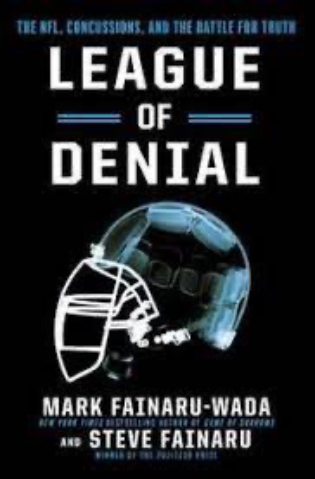Volume 5 Number 2
League of denial: the NFL, concussions and the battle for truth
Review by Richard Laherty
For referencing Laherty R. League of denial: the NFL, concussions and the battle for truth. JHTAM 2023; 5(2):7-9.
DOI https://doi.org/10.33235/JHTAM.5.2.7-9
League of denial: the NFL, concussions and the battle for truth
by Mark Fainaru-Wada and Steve Fainaru
Published 2013 Crown/Archetype

This book chronicles the journey to an acknowledgement and a reckoning of sorts that American football was hurting its players, some irrevocably, long after their playing days had finished. It was published in 2013 after a landmark class action court case where the National Football League (NFL) was ordered to pay around three-quarters of a billion US dollars to the players and their families who were suffering the late consequences of concussions received when they were playing.
The reader does not need a love of American football, nor even a great awareness of it, to recognise the similarities involved in the collisions and the contact between players on the gridiron and other gladiatorial sports that might be more common in other nations – heroes brought low by the very sports that they and their fans love. Australia has seen footballing heroes recently diagnosed with chronic traumatic encephalopathy (CTE) syndrome, including Wally Lewis1, James Graham2, Mario Fenech3 and Boyd Cordner4. Australia had the sad honour of being the first nation to diagnose CTE in a deceased female athlete, Heather Anderson5. World Rugby6 is currently involved in a class action brought by 300 ex-players. The evaluation of acute concussion in the military/austere combat setting is also a contemporary practice issue, with various tools being used to help deployed medics (or corpsmen) identify concussion in the deployed setting7. Our sports are still hurting their heroes.
This is a descriptive review of the 2013 work by Fainaru-Wada and Fainaru. We begin with a biography of Mike Webster, described as the “greatest center in NFL history”. We hear of his dedication and hard work as a junior, progressing through to his elevation to the NFL where he built a reputation for his ability to win collision after collision against his opponents both in training and in over 245 games. A Pittsburgh icon who, within just a few years of his retirement, was homeless, destitute, suffering with various undiagnosed mental health conditions and self-medicating with a variety of drugs and agents including tasers. On being inducted into the NFL Hall of Fame, he gave a rambling and disjointed speech. He died of a heart attack at age 50, just 12 years after retiring. In 1992 his was the first NFL player’s brain to reveal the pathologic features of CTE at autopsy. Indeed, through the nineties there were cases of players who retired after diagnosed concussions. 1994 was dubbed the Year of the Concussion. The reader is provided insights into these case histories and is introduced to the people who started to question the role their sport was playing in these career-ending injuries.
The book is pitched as a David vs Goliath story. The clinicians who began asking questions were framed as the ‘dissenters’ against the ‘defenders’ of the NFL’s status quo. The reader is introduced to some of the dissenters and is provided background to their motivations for exploring concussion and its impact. This ranged from the immigrant pathologist (Dr Bennett Omalu) who really had no knowledge of, nor interest in, football who decided to study Mike Webster’s brain on little more than a whim, to others who were lifelong football fans, involved with teams at various levels, who were concerned for the players and wanted to alert the NFL to potential problems, thinking the NFL would want to take corrective action.
However, when scientific questions were raised, the NFL claimed there was no evidence, reminiscent of the tobacco industry’s response to the proposal that cigarette smoking caused lung cancer. It took 2 decades of resistance before the NFL finally accepted that football caused concussion and that concussions could lead to further, later problems. This stance was enabled by the NFL committee responsible for obtaining and analysing the data that might answer the questions being led by NFL employees, a stance that was seemingly protective of the multibillion dollar industry. The journal Neurosurgery was involved in publishing NFL-funded research that was of poor quality, and the journal was co-opted into pressuring the dissenters into considering withdrawing their articles (for example Mike Webster’s CTE and the possible link to football) or modifying their conclusions to be less confronting. One published paper gave the opinion, not reflective of the population studied nor the data gathered, that it was acceptable for concussed players to return to play during the game in which they were concussed, including school and college players.
Despite this, researchers were able to slowly gather evidence, and with it increase the awareness of players and eventually the public. A cognitive assessment tool put together by Lovell8 in the 1990s was slowly developed, propagated through more and more teams (independent of the NFL), modified and refined to become the head injury assessment tool used today across many sports to help diagnose on-field concussion and to inform return to play recommendations.
Guskiewicz9 was one of the dissenters, publishing a number of papers in the 2000s based on surveys and questionnaires of former players. A total of 62% of 3683 retired players responded to his initial mailout. Concussion was described as “a blow to the head followed by a variety of symptoms that may include any of the following: headache, dizziness, loss of balance, blurred vision, ‘seeing stars’, feeling in a fog or slowed down, memory problems, poor concentration, nausea, or throwing up. Getting ‘knocked out’ or being unconscious does NOT always occur with a concussion”. A total of 60% of respondents were able to identify as having had at least one concussion; 25% had had at least three. More than half said they had lost consciousness on the field or experienced memory loss at least once. This study indicated that just one concussion resulted in a three-time increase in experiencing depression.
In further studies, Guskiewicz reported that players who self-identified as having three or more concussions in their playing career were five times more likely to be diagnosed with dementia. College footballers with one concussion were more likely to sustain a second, especially if the first had not had sufficient time to heal. These studies lead the authors to conclude that “Our findings suggest that the onset of dementia-related syndromes may be initiated by repetitive cerebral concussions in professional football players”; paraphrased by Fainaru-Wada and Fainaru as “Football causes brain damage” and countered by the NFL as that’s “just a theory”.
The first few post-mortems on players whose brains provided the CTE diagnosis spanned years. The original research group fractured, becoming two teams of ‘brain hunters’. The authors describe the first time one of the ‘brain hunters’ endeavoured to cold call a grieving family to try to ask their permission for brain tissue to study. On some occasions they were aided by the players, some of whom knew that something was not right within their brains and asked family to donate their bodies.
In a 2023 paper, 10 years after the book was published, the dominant brain hunter group (Boston University CTE Center) published that 345 of 376 brains of former NFL players autopsied showed CTE, compared with only one out of 164 general population autopsies (published in 2018). That one person had played college football10.
During the years of their defence, the NFL sought to build a better helmet. Helmet manufacturer Riddell claimed their helmets reduced concussion by 31%; this lead to them having the lion’s share of the helmet market. The claims were later shown to be based on flawed research.
The NFL’s reluctance to accept the possibility that concussion was a problem and the impact of what might be described as dodgy literature being quoted in support of early return to play became the crux of the various legal battles that were instigated by players or their families against teams and eventually the NFL itself.
For a long time, it had been thought that the NFL was not able to be sued due to the way in which the contracts were prepared and structured. A few players were successful in suing their clubs for breaches resulting in their early retirement or for their long-term health issues post-football. Player welfare eventually became better managed. The authors describe how this seemed schizophrenic as on the one hand players were being compensated for the consequences of their concussions (though not consistently) and yet the league was still saying that football was not to blame. California law became the vehicle through which a class action was able to be brought against the NFL, culminating in the 2013 payment instruction. It has been noted that NFL is now worth around US$25 billion a year and that the payout figure (of nearly US$1 billion, including US$220 million in legal fees) was a bargain for the NFL.
Once the writing was on the wall, the NFL modified the rules of its game, banning some tackling styles and promoting greater awareness amongst players and staff of concussion and the need to treat concussed players appropriately. The clashing helmet motif was removed from Monday Night Football promotional material.
At the conclusion of the book we are introduced to a player who was known for his toughness and we share a moment with him where he meets a young fan who tells him that he is going to grow up to be like him. The reader is reminded of a child’s love of the game and of the passion, aspiration, dedication and commitment needed to make it to the NFL. With the turn of a page we are transported a few years to where the player is being gently teased by his teammates because an opposition rookie is calling out to him – ‘I made it’. That rookie was Mike Webster.
Author(s)
Review by Richard Laherty
Senior Lecturer, University of Queensland, QLD, Australia
Email r.laherty1@uq.edu.au ORCID 0000-0002-6662-0312
References
- Read B. Rugby league legend Wally Lewis diagnosed with early signs of brain disease CTE. The Courier Mail. 30 July 2023. Available from: www.couriermail.com.au/sport/nrl/rugby-league-legend-wally-lewis-diagnosed-with-early-signs-of-brain-disease-cte/news-story/777727c170f89cd7f44215644343dbdf
- Alston J. James Graham reveals he has brain damage after suffering more than 100 concussions over his career – as he calls on the NRL to do more about head trauma. Daily Mail. 2022 Oct 8. Available from: www.dailymail.co.uk/sport/nrl/article-11292875/James-Graham-forced-return-concussions-early-contributed-brain-damage.html
- Reid H. NRL great Mario Fenech forgot his own son’s wedding – and a ‘silent, lonely killer’ is to blame. Seven News. 2022 Sep 18. Available from: 7news.com.au/sport/rugby-league/nrl-great-mario-fenech-forgot-his-own-sons-wedding-and-a-silent-lonely-killer-is-to-blame-c-8261068
- Halloran J. ‘I never really knew what the big fuss was about… until I felt the symptoms’. The Australian. 2022 Sep 16. Available from: www.theaustralian.com.au/sport/nrl/i-never-really-knew-what-the-big-fuss-was-about-until-i-felt-the-symptoms/news-story/57b5692839791d197a706ed0ad8cf6c1
- Suter CM, Affleck AJ, Pearce AJ, et al. Chronic traumatic encephalopathy in a female ex-professional Australian rules footballer. Acta Neuropathol 2023;146:547–549. doi:10.1007/s00401-023-02610-z
- Westerby J. Former rugby union players launch historic legal challenge over brain damage. The Sunday Times. 2022 Jul 25. Available from: www.thetimes.co.uk/article/former-players-launch-historic-legal-challenge-over-brain-damage-sx070qs89?gclid=EAIaIQobChMI5sPKw_DVgQMVt6lmAh1P-Q8vEAAYASAAEgJYXPD_BwE
- Khokhar B, Jorgensen-Wagers K, Marion D, Kiser S. Military acute concussion evaluation: a report on clinical usability, utility, and user’s perceived confidence. J Neurotrauma 2021;38(2):210–7.
- Lovell- Iverson GL, Franzen MD, Lovell MR. Normative comparisons for the controlled oral word association test following acute traumatic brain injury. The Clinical Neuropsychologist. 1999 Nov 1;13(4):437-41.
- Guskiewicz KM. Assessment of postural stability following sport-related concussion. Current Sports medicine reports. 2003 Feb 1;2(1):24-30.
- Sobey R. Boston University researchers find CTE in 345 of 376 former NFL players. The Orange Country Register. 2023 Feb 7. Available from: www.ocregister.com/2023/02/07/boston-university-researchers-find-cte-in-345-of-376-former-nfl-players/


